“We are all one circle.”—Eva, I Will Dance
Why this Book? Why will it matter to kids?
Show, don’t tell. It’s a writer’s creed and an educator’s quest in a read-aloud choice. A book that invites us to see, hear, and feel beyond our experience offers a powerful opportunity to grow. When children engage with a book that expands perspective and deepens understanding, one that celebrates inclusive actions and instigates reflection, their horizons—and their choices—broaden.
Levels and Layers of Learning
Acceptance, compassion, concern, connection, courage, creativity, dedication, diligence, effort, empowerment, fortitude, friendship, generosity of spirit, gratitude, helpfulness, hope, humility, inspiration, integrity, justice, kindness, passion, perseverance, persistence, perspective, resilience, resourcefulness, respect, self-assurance, self-awareness, self-reliance, tenacity, understanding
Community, Physical Education
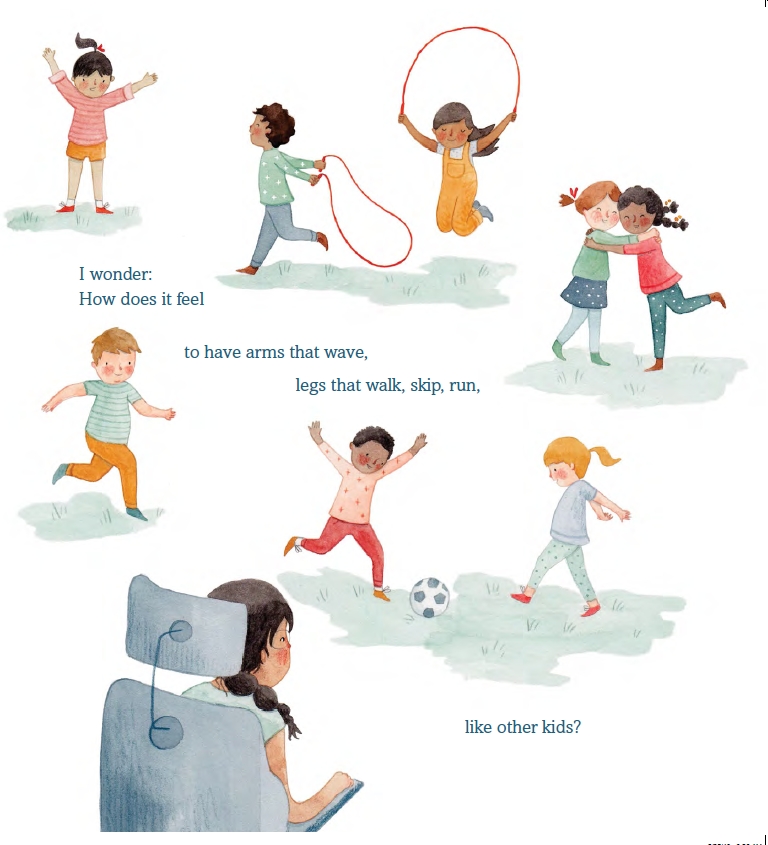
Using This Book in the Classroom
Hit the Ground Running
Ready Resources for Educators, Homeschoolers, and Parents
Write Away!
Ideas to prompt writing
Write about a time when you were determined to achieve something that you were having trouble accomplishing. All of us have faced obstacles. Some of us may remember how hard it was to learn to ride a two-wheeler or to memorize math facts. Others of us may recall something less common or more serious, but all of us have faced hurdles that took determination and resolve to accomplish. Share your experience.
The author of this book uses words that help us to feel and see and hear what Eva is experiencing. Find words and sentences in the text that appeal to you. Explain why you chose them.
Eva learns that “we are all one circle.” Explain what that means to you.
List ways you can include others and make them feel welcome and important. Illustrate your favorite for a classroom mural that circles the classroom.
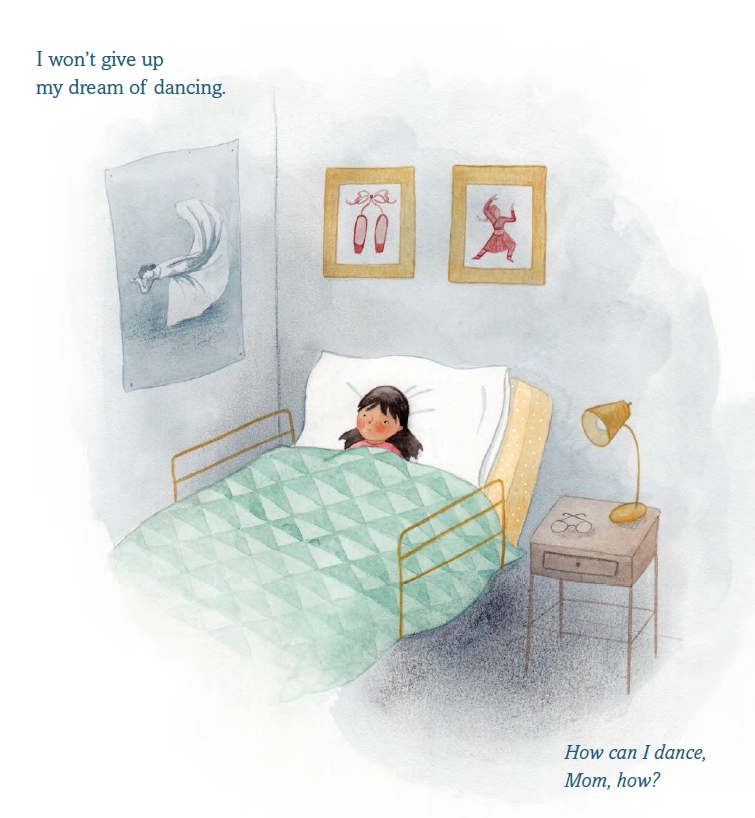
Poetry Break
Related poetry to recite before or following the reading of this book
Poetry fits perfectly into brief moments in the day—from morning opening to lining up for lunch; from transitioning between subjects to zipping up backpacks at dismissal. Reading a poem typically takes less than a minute, yet it can introduce or reinforce a concept, celebrate language, exemplify rhythm, enhance vocabulary, expand understanding, increase attention span, initiate reflection, or summon a giggle. And, poetry soothes the spirit.
- Amphibian Acrobats by Leslie Bulion, illustrated by Robert Meganck
- Dictionary For A Better World: Poems, Quotes, and Anecdotes from A to Z by Irene Latham and Charles Waters, illustrated by Mehrdokht Amini
- Tap Dancing on the Roof Sijo (Poems) by Linda Sue Park, illustrated by Istvan Banyai
And Then There’s This…
Enrichment activities, related books, online resources, craft projects, and ideas for further study
Nancy suggests the following resources:
“Infusing Disability Studies into the General Curriculum,” a brochure by Phil Ferguson, University of Missouri, for The National Institute for Urban School Improvement offers top-notch points and curriculum suggestions.
White Plains Library Celebrates International Day Of Persons With Disabilities offers a list of books recommended for Preschool–Grade 2. See also see their lists for Middle Grade and YA.
USBBY (or IBBY, International Board on Books for Young People) has compiled a list of outstanding books focusing on a diversity of aspects relating to children and disabilities.
Magination Press, an imprint of the American Psychological Association is a worthy resource of books for children that address social-emotional issues.
Colorado Parent Magazine compiled an excellent list of recommended children’s books.
The Schneider Family Book Award is given each year to outstanding fiction and nonfiction books that focus on children and disabilities.
Related Picture Books of Interest:
Special Needs
- Can Bears Ski? by Raymond Antrobus, illustrated by Polly Dunbar (hearing)
- I Can See Just Fine by Eric Barclay (vision)
- I Talk Like a River by Jordan Scott, illustrated by Sydney Smith (stuttering)
- Jacob’s Eye Patch by Beth Kobliner Shaw and Jacob Shaw, illustrated by Jules Feiffer (vision)
- Just Ask! Be Different, Be Brave, Be You by Sonia Sotomayer, illustrated by Rafael López (a variety of special needs including diabetes)
- Naomi Knows It’s Springtime by Virginia L. Kroll, illustrated by Jill Kastner (blindness)
Inclusion
- All Are Welcome by Alexandra Penfold, illustrated by Suzanne Kaufman
- Be Kind by Pat Zietlow Miller, illustrated by Jen Hill
- Danbi Leads the School Parade by Anna Kim
- The Day You Begin by Jacqueline Woodson, illustrated by Rafael López
- I Walk with Vanessa: A Story About a Simple Act of Kindness by Kerascoët
- Show Some Kindness, Bring Some Light by Apryl Stott
- Strictly No Elephants by Lisa Mantchev, illustrated by Taeeun Yoo
- The Big Umbrella by Amy June Bates with Juniper Bates
- Words and Your Heart by Kate Jane Neal
- You Matter by Christian Robinson (inclusion)
Dance
- Alicia’s Tutu by Robin Pulver, illustrated by Mark Graham (an all-time favorite of mine)
-
- B Is for Ballet: A Dance Alphabet by John Robert Allman, illustrated by Rachael Dean
- Boys Dance! by John Robert Allman, illustrated by Luciano Luzano
- Bunheads by Misty Copeland, illustrated by Setor Fiadzigbey
- Dance Like a Leaf by AJ Irving, illustrated by Claudia Navarro
- Dancing to Freedom: The True Story of Mao’s Last Dancer by Li Cunxin, illustrated by Anne Spudvilas
- Dumpy LaRue by Elizabeth Winthrop, illustrated by Betsy Lewin (Find a read-aloud plan in Children’s Book Corner, Grades 1-2.)
- Firebird by Misty Copeland, illustrated by Christopher Myers
- Giraffes Can’t Dance by Giles Andreae, illustrated by Guy Parker-Rees
- How Do You Dance? by Thyra Heder (Coretta Scott King Award; Ezra Jack Keats Honor)
- How Do You Wokka-Wokka? by Elizabeth Bluemle, illustrated by Randy Cecil
- Jingle Dancer by Cynthia Leitich Smith, illustrated by Cornelius Van Wright and Ying-Hwa Hu
- Kitchen Dance by Maurie J. Manning
- Let’s Dance! by Valerie Bolling, illustrated by Maine Diaz
Nancy offers the following list of recommended books featuring differently-abled characters:
Picture Books
- After the Fall; How Humpty Dumpty Got Back Up by Dan Santat
- All the Way to The Top: How One Girl’s Fight for Americans with Disabilities Changed Everything by Annette Bay Pimentel, illustrated by Nabi H. Ali
- Ani’s Light by Tanu Shree Singh, illustrated by Sandhya Prabhat
- Aunt Pearl by Monica Kulling, illustrated by Irene Luxbacher
- Can I Play Too? by Samantha Cotterill (Little Senses series; helps kids on the autism spectrum understand social cues.)
- Colors of the Wind: The Story of Blind Artist and Champion Runner George Mendoza by J. L. Powers, illustrated by George Mendoza
- A Friend for Henry by Jenn Bailey, illustrated by Mika Song (Schneider Family Book Award Honor Book)
- Emmanuel’s Dream: The True Story of Emmanuel Ofosu Yeboah by Laurie Ann Thompson, illustrated by Sean Qualls
- Hello Goodbye Dog by Maria Gianferrari, illustrated by Patrice Barton
- Henny by Elizabeth Rose Stanton
- How Does It Feel to be Old? by Norma Farber, illustrated by Trina Schart Hyman
- I Am a Bear by Jean-François Dumont
- Look up! by Jung Jin-Ho, translated by Mi Hyun Kim
- Now One Foot, Now the Other by Tomie de Paola
- Remembering Ethan by Lesléa Newman, illustrated by Tracy Nishimura Bishop
- The Sound of All Things by Myron Uhlberg, illustrated by Ted Papoulas
- Too Sticky! Sensory Issues with Autism by Jennifer Malia, illustrated by Joanne Lew-Vriethoff
- Wilfred Gordon McDonald Partridge by Mem Fox, illustrated by Julie Vivas
Middle Grade
- BAT series (A Boy Called Bat, Bat and the Waiting Game, Bat and the End of Everything) by Elana K. Arnold, illustrated by Charles Santoso
- Braced by Alyson Gerber
- The Distance Between Me and the Cherry Tree by Paola Peretti, translated by Denise Muir
- Freak the Mighty Rodman Philbrick
- King for a Day by Rukhsana Khan, illustrated by Christiane Krömer
- Missing May by Cynthia Rylant
- A Monster Calls by Patrick Ness, illustrated by Jim Kay
- My Name is Layla by Reyna Marder Gentin
- Planet Earth Is Blue by Nicole Panteleakos
- Rogue by Lyn Miller-Lachmann
- Roll with It by Jamie Sumner
- Show Me A Sign by Anne Clare LaZotte
- Song for a Whale by Lynne Kelly (Schneider Family Book Award)
- The Space We’re In by Katya Balen
- The War That Saved My Life by Kimberly Brubaker Bradley (Schneider Family Book Award)
Note: I would add and encourage you not to miss:
- The Truth as Told by Mason Buttle by Leslie Connor (National Book Award Finalist, Schneider Book Award)
Young Adult
- I Am Not A Label: Thirty-four Disabled Artists, Thinkers, Athletes, and Activists From Past and Present by Cerrie Burnell, illustrated by Lauren Baldo
- Flowers for Algernon by Daniel Keyes
- The Silence Between Us by Alison Gervais (Schneider Family Book Award Honor Book)
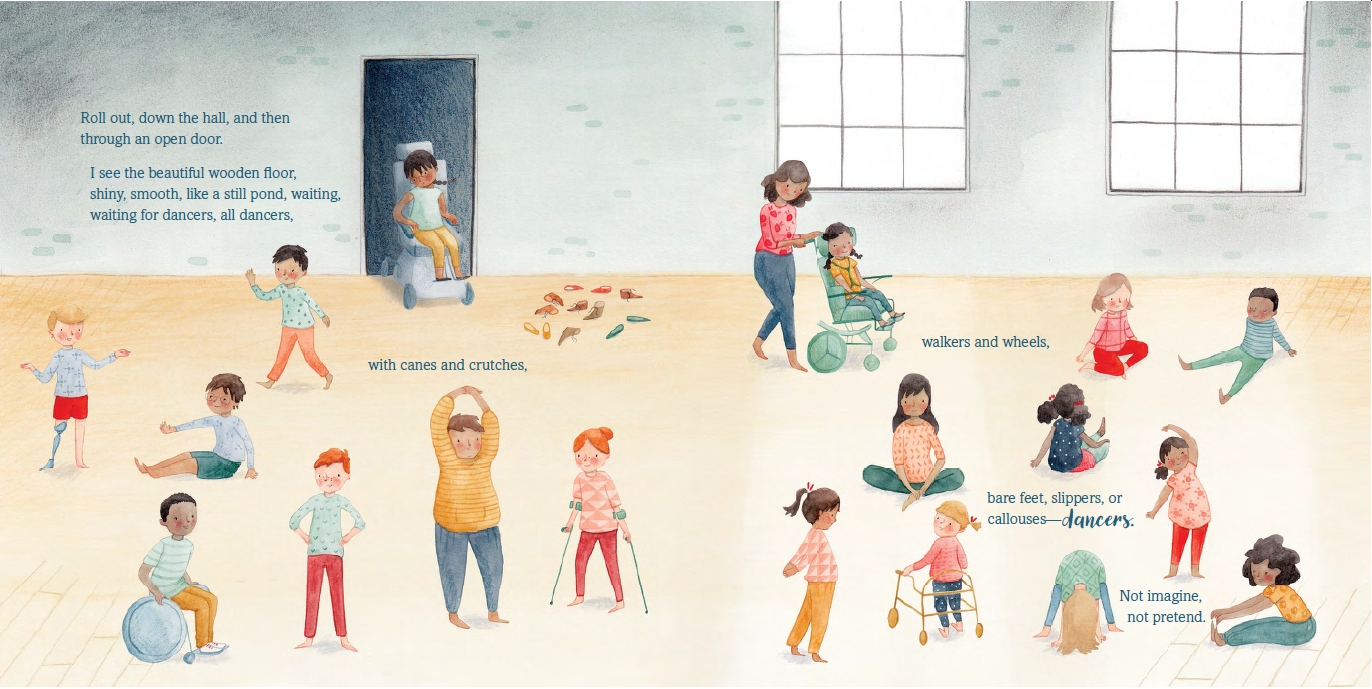
Meet the Author
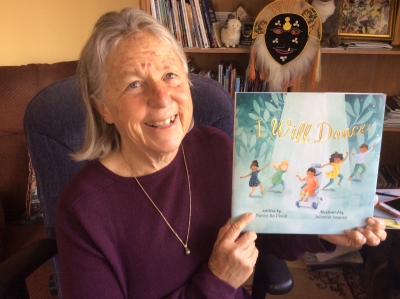
Nancy Bo Flood lived on the Navajo Nation and worked as a counselor, teacher, and author. With other teachers she encouraged students to read often and to write their own stories. Her middle grade novels include: Soldier Sister, Fly Home; Warriors in the Crossfire, and No-Name Baby. She has also written a number of picture books, including: Cowboy Up! Ride the Navajo Rodeo; First Laugh, Welcome Baby (with Rose Tahe); and I Will Dance.
Nancy Bo Flood’s books have garnered a variety of awards, but she believes the best reward is when a child looks up while reading one of her books and proudly says, “I am in this book.” You can find her extensive list of awards on her website.
Backstory: Q & A with Nancy Bo Flood
Judy Bradbury: How did you come to write I Will Dance? What kernel seeded its creation?
Nancy Bo Flood: I watched this unique company of dancers, Young Dance—all abilities, all ages—move with such joy, my tears tumbled down. What did I see and hear? Giggles, smiles, laughter, hugs; a community sharing their passion–dance! Watching the faces of the dancers so full of joy, feeling their joy, was the kernel that seeded the creation of this book.
Dancers moved across and around the stage, some in wheelchairs, some with walkers, and some with independent mobility. Each dancer was in awareness of the others; each dancer was a part of the whole. At performances, when I glanced around at the audience, what did I see? Not pity or sadness, but delight, amazement, joy. Tearful joy.
I wanted to share this experience with others: readers with disabilities, and readers without disabilities. My understanding of what it means to have a physical disability was changed. A shift from cannot to can. A shift from “you are different” to “we are the same.”
All of this is what Eva, the real girl who inspired this book, taught me. Eva was born in India. An orphan born prematurely, hardly able to breathe or move, she was not expected to live.
Because of her early birth, Eva developed cerebral palsy, CP. She was unable to move most of her muscles, even the muscles of her neck and face. Eva was adopted by an American family of two mothers and one brother.
Like every child, Eva was born with dreams. Let me try. With longings. Let me belong. And with the desire to be, and to become, herself. Eva, a doer. Eva, a dancer. Eva, a young woman who loves to read, share a mocha coffee with a friend, have her hair styled, and look pretty.
JB: Tell about one hurdle you experienced in the creation of I Will Dance or provide a memorable (or humorous!) anecdote related to the making of this book.
NBF: As I was driving across Minneapolis trying to find the dance studio, I became totally lost. I was driving in circles on the freeway trying not to cry. Cars were honking and zooming around me. Dancers were waiting to be interviewed after their classes. Like Eva in the book, I wanted to turn around and run away. And then there it was, the exit I had been looking for.
My biggest emotional hurdle was finding the story while asking myself, “Whose story? What story? and Could I tell this story?”
JB: What did you learn from creating I Will Dance?
NBF: We all seek and need “community,” being with people who understand “me,” who share our passions and interests, whatever they are. People we can hug, laugh with, cry with, get frustrated with, and still continue to be friends. Being part of a community also means being an authentic member, someone who contributes, has a place, a role, and is valued for those contributions.
JB: What would surprise readers to learn about you or about the creation of I Will Dance?
NBF: I love to tap-dance. My first—and last—solo (when I was seven) was tapping and singing, “How much is that doggie in the window?” Sometimes when I am home alone, I do a little shuffle off to ….Buffalo…Broadway?
Another very different surprise: I once was a research scientist who operated on fish brains.
JB: This picture book celebrates pursuing dreams which seem unreachable, but even more so, the joy of being welcomed and accepted. How did you determine the resolution/final scene in the story?
NBF: Eva at first was questioning herself, full of self-doubts: “can I do this, do I belong, or should I turn around and go home?” Eva overcame those fears as she experienced, “yes, I can” and also, equally important, “yes, I am a real part of this dance company, valued for who I am—me—not my disability. I can share what I have created with others.”
In the final scene–performance night–Eva dances, not imagined, not pretend, not alone.
JB: What insight do you hope to share with readers?
NBF: When I was in first grade, “Crayon Bobby” sat in the back of the classroom. He never spoke and no one ever spoke to him. All day he sat at his desk with a white sheet of paper and a tin can of broken crayons. Our teacher told us to give her used crayons we no longer wanted and she would put them in Bobby’s crayon can.
I’ve never forgotten Bobby.
I hope I will always see a child first as an individual who has the same needs and desires as all children: to belong, to develop interests, to learn, grow, have friends, and to be a contributing part of a community.
Each child has the right to see themselves in books. While the need for more diverse books is now recognized, too often this is limited to diverse races or cultures. Diversity also includes the diversity of abilities: physical, emotional, intellectual, and neuro-different.
JB: How do you see I Will Dance connecting to curriculum?
NBF: I think about social-emotional learning and also early elementary science and health curriculum as children explore who am I, my body, feelings, expression of feelings, etc. Social-emotional learning includes exploring how we are the same or different from others. As school curriculum continues to expand awareness of and discussions about diversity, I hope it will include the diversity of abilities: what is a disability, what does that mean, and if someone has a disability, how is that person different from, and the same as, me?
People with disabilities are one of the largest (over 50 million Americans) and least understood minority groups. Few books show the meaning of this experience. Few books provide children who have a disability the opportunity to see themselves in a book. Additionally, few books offer children without a disability an opportunity to understand this experience.
JB: What’s next?
NBF: I am working on a picture book that reflects the emotional journey of being with someone you love and that someone is dying. The story is told from the perspective of a child who is experiencing the death of a grandparent and having to let go while holding on.
During this time of Covid, I’ve become aware of how difficult it is for dancers to continue dancing, choreographing, and performing. I began interviewing dancers with disabilities to learn what it means to be in quarantine, away from one’s community, away from a place of gathering and sharing, and continue to dance. Their responses are amazing. Dancing During Covid became a series of posts which can be found on my website.
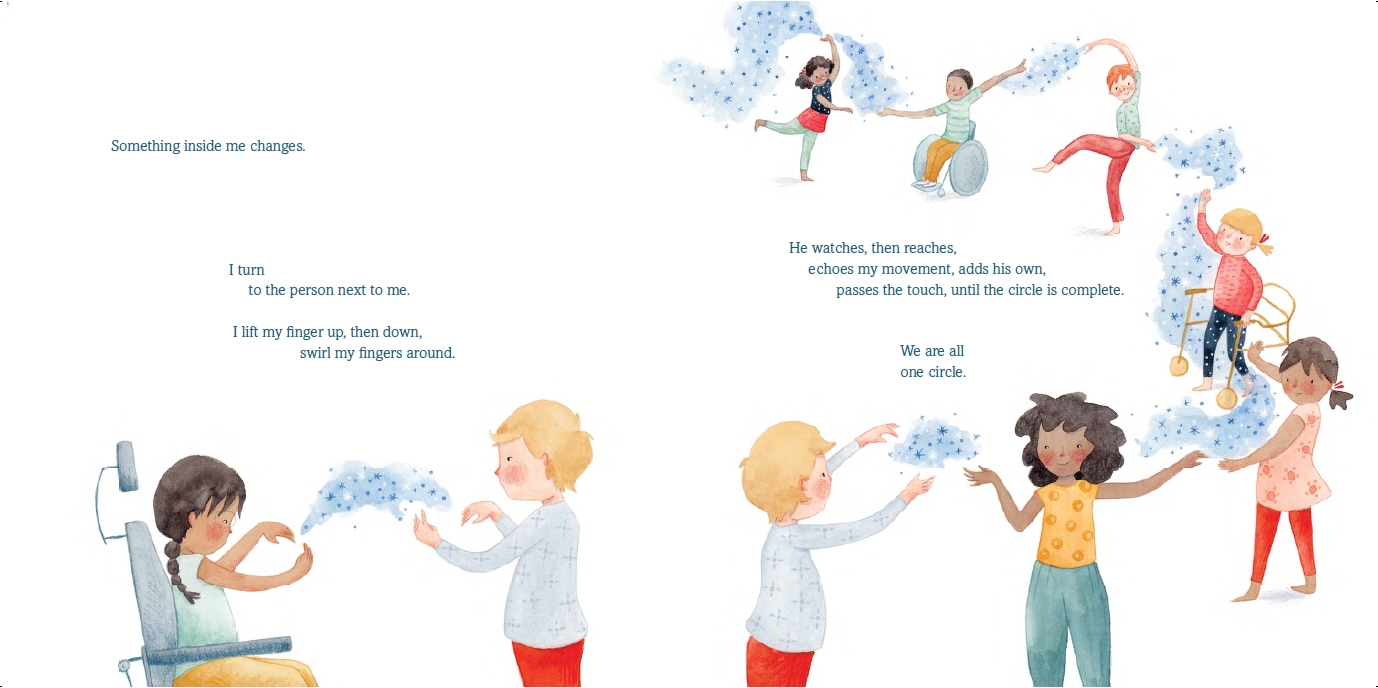
Over to You…
What picture book centering on differently-abled children or on dance do you recommend?
Final Thought
“Story is a powerful way to build compassion and bridge understanding between cultures. Story has the power to heal as well as teach.” ~ Nancy Bo Flood

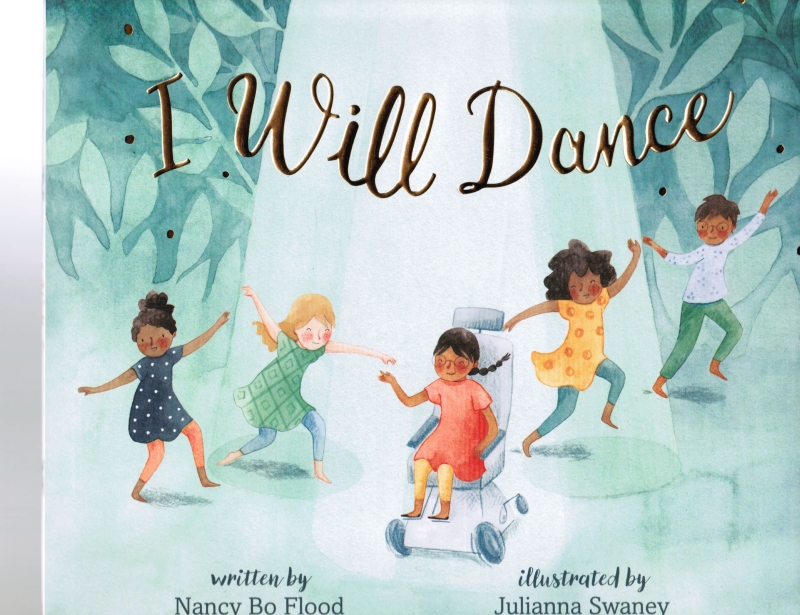
Eva–and Nancy Bo Flood–sound like remarkable people. And this book sounds great–capturing the longing, apprehension, and joy of the character. The pictures of the dancers make ME want to dance.
I couldn’t agree more, Vivian. The illustrations, and the lyrical language, make for a utterly engaging book. Thanks for sharing!